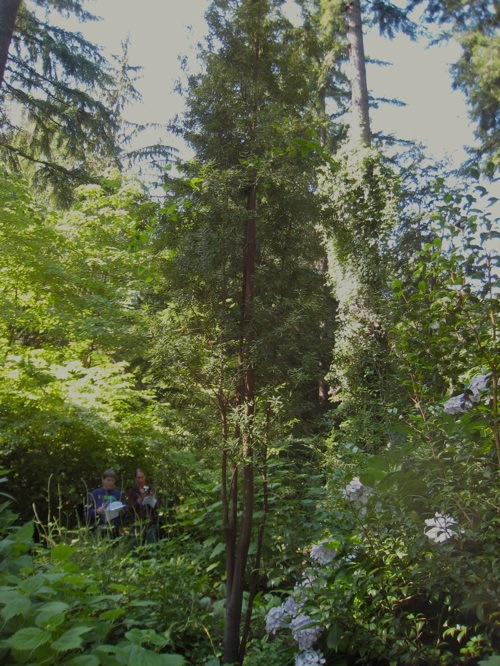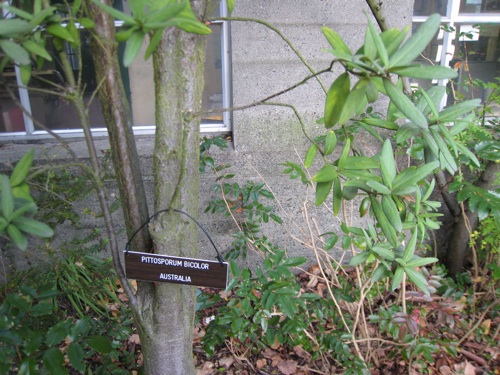| Pittosporum is an Old World genus of around 200 species of evergreen trees and shrubs. Pleasingly, most bear sweetly fragrant flowers. Sadly, most are not frost-hardy. A species that is more or less hardy, and of an especially useful size and shape, is my present subject. |
| Native to Tasmania and SE Australia (New South Wales and Victoria), the Banyalla is remarkably narrow and its branches upswept. This, plus its relative frost-tolerance, shade tolerance, and pleasing appearance, combine to make it a valuable --yet little known-- shrub or slender small tree. It should play a larger role in urban places where there is much shade and little room for broad trees. For example, in between neighboring houses. |
| Besides Banyalla or Banalla (aboriginal name in Victoria), it is also known as Cheesewood --"due to the cheesy texture of the wood when first cut." The wood was used by Tasmanian aborigines for clubs called waddies, so a third name is Waddywood. Settlers used it for axe-handles, billiard-cues, and the like. A fourth name, Tallow-wood, is also applied to the huge-growing Eucalyptus microcorys. Still more names are Tolosa Wood, Whitewood, and Dragon's Blood. |
| Introduced to Europe by 1854, and in California by 1871 (but still "rare" there in 1910), Banyalla seems to have been in Pacific Northwest cultivation only since October 1973, when Washington Park Arboretum in Seattle got cuttings from Kew, England. Though those three specimens were dead by 1980, cuttings had been taken from them. Heronswood Nursery sold it at least from 1991 until 1997. Forest Farm and Cistus nurseries in Oregon also have sold specimens. |
| The ForestFarm catalog said: This neat erect large shrub / small tree makes a fine hedge or specimen with its narrow leaves and stalks of bright summer "bell" flowers (yellow, tinted maroon or crimson) hanging from branch tips, followed by seeds in red sticky pulp. |
| The Heronswood catalog said: Highly textural, dark evergreen foliage and fragrant white flowers on erect stems to 8 feet. For mild localities, hardy to 15 degrees F, but will resprout from the roots if killed to the ground. Well, isn't that reassuring? It thrives undamaged in our light woodland. |
| To me, its foliage much recalls that of Labrador Tea (Ledum grœnlandicum; now called Rododendron g.). Each leaf is narrow, dark green on top, and pale with felty hairs underneath --fitting the name bicolor. The leaves measure 1 to 3 inches long, up to three-forths of an inch wide. They are thick, their margins rolled under; and they are whorled or spiraled around the twigs. |
| Mildly fragrant little flowers are reported to be borne anytime between November and April (in the Southern Hemisphere, between July and December). They are described variously as to color and size. I have not examined any. The consensus is that they are cream or yellow, usually with pink, red or purple-maroon markings --fitting the name bicolor. Seed-capsules ensue, opening to reveal lovely orange seeds. They are sticky. The 1788 name Pittosporum derives from the Greek pitta (pitch) and sporum (a seed) --hence pitch seed. |
| In the wild, this species has been reported as tall as 44 feet (14 m). The tallest I found referenced for cultivation was 33 feet in Mount Usher, County Wicklow, Ireland. In Seattle, one at the Carl English gardens at the Locks is 23.5 feet tall (it dates to about 1990). At Heronswood Garden near Kingston, Washington, one is 22.5 feet tall. One 17 feet tall is in a Bellevue garden. It is also at the UBC Asian garden, and at Portland's Hoyt Arboretum. A private Seattle garden has three, and one is at Miller Botanic Garden. I desire to learn about others in or near Seattle. My photographs below are poor, but do indicate clearly the slender shape of the tree. |
| It is said to prefer "a shaded location in a well-composted soil" and "needs ample moisture" (Australian Native Plants, 2nd edition, 1983; by John W. Wrigley and Murray Fagg). The website TazWild Plants (tazwild.com)says: "moist but well drained acidic soils; shade to part shade; responds well to pruning." I think it should also be tested in unirrigated sites, assuming it is watered for the first few years after planting. |
Propagation is by seed or half-ripened wood cuttings. But it is not an easy species in this regard, and that is the main reason it is so rarely cultivated. It hybridizes with Victorian Box P. undulatum. 'Cradle' and 'Mount Field' are cultivars listed in the RHS Plant Finder --meaning they are sold in the UK. Both names refer to locations in Tasmania.
Back |

Heronswood Pittosporum bicolor; photographed August 30 2009 by ALJ
|

Pittosporum bicolor at the Locks; photographed November 2009 by ALJ
|

Pittosporum bicolor at the Locks; photographed November 2009 by ALJ
|

